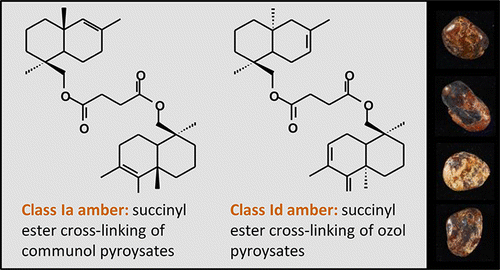One secret of ancient amber revealed

The warm beauty of amber was captivating and mysterious enough to inspire myths in ancient times, and even today, some of its secrets remain locked inside the fossilized tree resin. But for the first time, scientists have now solved at least one of its puzzles that had perplexed them for decades. Their report on a key aspect of the gemstone's architecture appears in the ACS journal Analytical Chemistry.
Jennifer Poulin and Kate Helwig of the Canadian Conservation Institute point out that much of the amber we see today had its origins millions of years ago, when it exuded from trees and then fossilized over time. Some of the oldest recovered samples even predate the rise of dinosaurs—and could outlast even the most advanced materials that science can make today. But it's exactly that extreme durability that has made amber's internal structure so difficult to understand. Scientists have used one particular technique to probe the inner molecular architecture of the ancient resin, but the process seemed to destroy evidence of certain relationships between compounds. Poulin and Helwig decided to try a new approach.
Building on past attempts using something called pyrolysis-gas chromatography-mass spectrometry, they slowed down the pyrolysis phase, which essentially uses heat to break down a substance. By doing so, the researchers were able to show that specific groups of atoms within their samples were bound to succinic acid, known historically as "spirit of amber." "There can be no doubt that much of the stability and durability of certain kinds of amber comes from the succinic acid cross-linking within the matrix," the researchers said.
More information: "Inside Amber: The Structural Role of Succinic Acid in Class Ia and Class Id Resinite" Anal. Chem., Article ASAP. DOI: 10.1021/ac501073k
Abstract
For the first time, molecular evidence of the structural role played by succinic acid within the macromolecular structure of Class Ia and Class Id resinite is presented. Using a novel gas chromatographic methodology, communol (Class Ia) and ozol (Class Id) moieties within the polylabdane matrix are shown to be cross-linked with succinic acid. Samples were analyzed using pyrolysis-gas chromatography–mass spectrometry with in situ hexamethyldisilazane derivatization, using a thermal separation probe to perform the pyrolysis and sample introduction. The relatively slow rate of heating and prolonged pyrolysis of resinites using this new methodology, combined with the use of a mild derivatization reagent, allowed communol pyrolysates from Class Ia resinite and ozol pyrolysates from Class Id resinite to elute with unbroken succinyl ester cross-linkages. These results provide direct molecular evidence that the key role of succinic acid within Class Ia and Class Id resinite is to cross-link the macromolecular structure. In the Class Id resinite, the methodology also allowed the detection of succinyl ester linkages between ozol pyrolysates and dehydroabietol, thus demonstrating that nonpolymerized diterpenes contribute structurally to the macromolecular structure of Class Id resinite.
Journal information: Analytical Chemistry
Provided by American Chemical Society


















